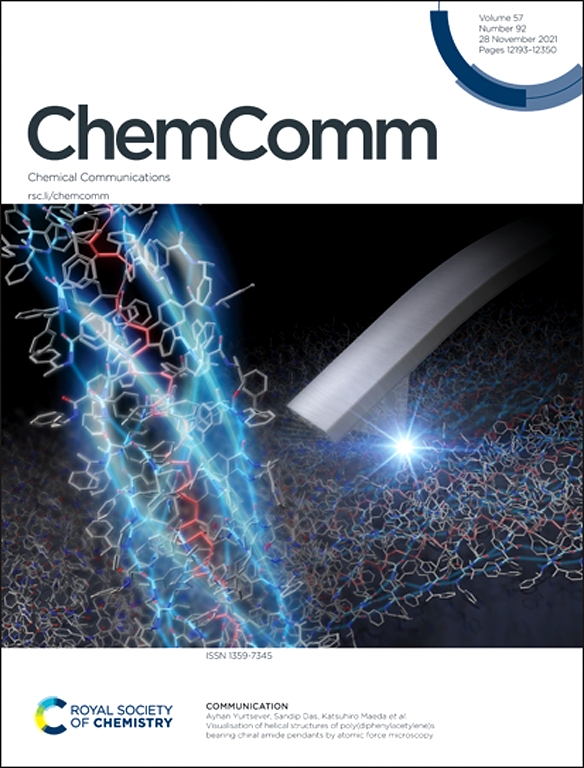光功能环镜主客体系统
IF 4.2
2区 化学
Q2 CHEMISTRY, MULTIDISCIPLINARY
引用次数: 0
摘要
通过智能蛋白质基质调制光学性质的例子有几个,如紫红质(吸收波长调谐)和绿色荧光蛋白(发射),但总的来说,在自然界中发现的矩阵控制光功能的范围仍然相当有限。在这篇综述中,我们提出了基于环烷的超分子宿主-客体复合物,其中环烷宿主和大多数平面芳香客体分子之间的电子相互作用可以以更先进的方式主动调节激发态性质,包括单线态和三重态激发态。我们首先强调光功能主客系统的开关荧光开关和热效应功能使用湾功能化苝酰亚胺环番。接下来,我们研究了苝酰亚胺环烷中π-延伸对多客体结合的影响,展示了包括圆偏振发光(CPL)在内的光功能特性。然后,我们将重点放在三重生成环烷上,即冠烯二亚胺环烷,具有高系统间交叉(ISC)速率,在那里我们展示了客体封装和三重态敏化的激发态途径的调制,通过磷光和热激活延迟荧光(TADF)。此外,利用超分子策略,我们提出了非共价设计,包括基于重原子的Pt(acac)2客体或重原子自由电荷转移配合物,在环境条件下收获三重态,并证明了超分子纳米环境在稳定加气溶液中的三重态激子中的作用。此外,我们还展示了水溶液中环烷配合物中三重态-三重态湮灭(TTA)上转换的例子,以及主客体化学在有机发光二极管(oled)中的应用。本文章由计算机程序翻译,如有差异,请以英文原文为准。


Photofunctional cyclophane host–guest systems
Modulation of optical properties through smart protein matrices is exemplified by a few examples in nature such as rhodopsin (absorption wavelength tuning) and the green fluorescence protein (emission), but in general, the scope found in nature for the matrix-controlled photofunctions remains rather limited. In this review, we present cyclophane-based supramolecular host–guest complexes for which electronic interactions between the cyclophane host and mostly planar aromatic guest molecules can actively modulate excited-state properties in a more advanced way involving both singlet and triplet excited states. We begin by highlighting photofunctional host–guest systems for on–off fluorescence switching and chiroptical functions using bay-functionalized perylene bisimide cyclophanes. Next, we examine the impact of π-extension in perylene bisimide cyclophanes for multiple guest binding, showcasing photofunctional properties including circularly polarized luminescence (CPL). We then focus on triplet-generating cyclophanes, i.e. coronene bisimide cyclophane, with high intersystem crossing (ISC) rates, where we demonstrate modulation of excited state pathways upon guest encapsulation and triplet sensitization through phosphorescence and thermally activated delayed fluorescence (TADF). Furthermore, using supramolecular strategies, we advance non-covalent designs, involving either heavy-atom-based Pt(acac)2 guests or heavy-atom free charge transfer complexes, for triplet harvesting under ambient conditions and demonstrate the role of supramolecular nanoenvironments in stabilizing triplet excitons in aerated solutions. Additionally, we showcase examples for triplet–triplet annihilation (TTA) upconversion in defined cyclophane complexes in aqueous solutions and the application of host–guest chemistry in organic light-emitting diodes (OLEDs).
求助全文
通过发布文献求助,成功后即可免费获取论文全文。
去求助
来源期刊

Chemical Communications
化学-化学综合
CiteScore
8.60
自引率
4.10%
发文量
2705
审稿时长
1.4 months
期刊介绍:
ChemComm (Chemical Communications) is renowned as the fastest publisher of articles providing information on new avenues of research, drawn from all the world''s major areas of chemical research.
 求助内容:
求助内容: 应助结果提醒方式:
应助结果提醒方式:


